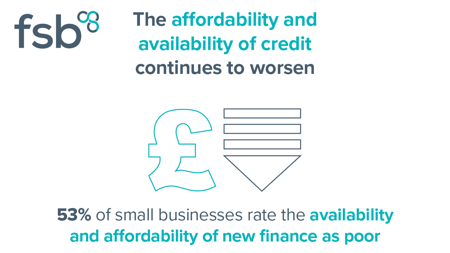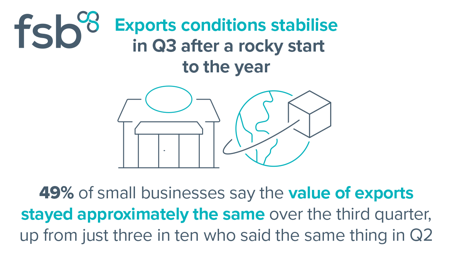Foreword

Tina McKenzie,
FSB Policy Chair
The summer of 2023 was a bit of a damp squib weather-wise, with grey skies and unusually high rainfall levels dampening what should have been three months of greater leisure and enjoyment. It’s therefore perhaps fitting that the Small Business Index’s headline confidence measure stayed in negative territory, thanks to a variety of factors.
Perhaps we shouldn’t read too much into weatherrelated metaphors; after all, the same quarter last year saw scorching temperatures and seemingly endless sunshine, and also a near-record low for small business confidence, due to the cost of doing business crisis, especially the dizzying spike in energy prices which caused so much pain to the small business community. We can be thankful that price rises and gas and electricity bills have fallen back, compared to the punishing heights of this time last year, but inflation is still far higher than we’d like it to be, while an upward trend in fuel prices is causing unease.
The Q3 confidence measure reading of -8 points is also higher than the second quarter’s finding of -14.2 points, which is cause for some relief – even if the economic indicators for the final quarter of the year look less than glowing.
Overall, the message coming from the Q3 report is one of tentative stabilisation in some areas, with slight falls in proportions of firms reporting or hoping for growth, or experiencing or fearing a contraction.
Among exporters, for example, the percentage reporting that export volumes remained approximately the same over the past three months leapt from three in ten (30.3%) in Q2 to nearly half (48.7%) in Q3. The proportion of all small firms who expect to remain approximately the same size over the next year ticked up from 34.6% in Q2 to 37.7% in Q3. Capital investment expectations for the coming quarter were expected to stay approximately the same for 52.3% of small firms in Q2, and for 55.5% of small firms in Q3. The proportion of small firms who said their late payments had neither improved nor worsened over the previous quarter edged up from 23.6% in Q2 to 25.9% in Q3.
Revenues over the previous quarter were marginally better than those reported in Q2, in keeping with the small recovery in confidence levels. A third (33.5%) of small firms reported that revenues increased over Q3, essentially unchanged from the previous quarter (Q2: 32.7%). Meanwhile, the proportion of small businesses reporting a drop in revenues over Q3, at 39.4%, was slightly lower than the 41.3% saying the same thing in Q2.
Given the turbulence of the recent past, this is welcome to a degree, but we must be wary that stabilisation does not turn into stagnation. There are also external signs of a potentially difficult winter ahead, such as a fall in consumer confidence levels in October, anaemic GDP growth in August following a notable drop of 0.6% in July, and indications from the labour market survey that unemployment levels may be rising and vacancies falling.
The findings of our research echo these warnings. The consumer-facing sectors of hospitality and retail have confidence readings far below the overall rate for small firms (-31.1 points for accommodation and food service activities; -22.8 points for retail and wholesale businesses; -8 points for all firms). The domestic economy is once again the most commonlycited barrier to growth, named by over three fifths of small firms (63.5% in Q3, against 61.5% in Q2). Hiring intentions for the coming quarter have also fallen back, with 11.7% of small firms planning to take on new employees, down from 15.5% who planned to do the same in the previous quarter.
The Q3 survey also raises a cautious alarm over inflation, which only fell by 0.1% over the three months in question, according to the ONS. The series record high of 91.8% of small firms who said their cost of doing business was higher than in the same period a year ago was recorded in Q1 2023, and fell back to 84.9% in Q2. However, hopes that this fall would continue were confounded, as 86% of small firms in Q3 said their running costs were higher than in the same quarter in 2022. The main culprits for higher running costs were utilities (57.3%), inputs (43.1%), and labour costs (42.8%). Fuel came next in the list, at 40.4%, up from 37.3% in the previous survey – and with pump prices rising, we are concerned that small firms will be hit by higher petrol and diesel costs as the year rolls on.
One point of relief in Q3 came in September as the Bank of England decided on a knife-edge 5-4 decision to hold the base rate at 5.25%, following 14 successive increases. With access to finance rated as poor by 53% of small firms in Q3, and with three in ten successful finance applicants (30.1%) offered a rate of 11% or more, we think there is a strong case for the Bank not to hike the base rate any further, especially with much of the pain of rate rises yet to hit in full.
Small firms are paying close attention to the stalls being set out by political parties as the next general election gradually comes into view. But in the shortterm, as the festive season approaches, the ‘golden quarter’ becomes vital for sectors like hospitality and retail facing challenges. Improving their operating environment will benefit the economy over the next few months and the distant horizon, as well as delivering political dividends.
Key findings

[Image text] Finding appropriately skilled staff continues to be a barrier to growth in the IT sector.

[Image text] The affordability and availability of credit continues to worsen.

[Image text] Exports conditions stabilise in Q3 after a rocky start to the year.
Executive summary
Key findings this quarter:
- The Small Business Index (SBI) increased to -8.0 in Q3 2023. This marked a return to improvement, following Q2’s fall to -14.2. Q3 represented the SBI’s sixth consecutive negative reading.
- Just two UK regions saw a positive reading on the regional SBI in Q3 2023. Nevertheless, five regions saw an improvement in the measure when compared to Q2 2023.
- Many sectors recorded negative readings in Q3, despite quarterly improvements. This highlights the continuing negative sentiment amongst small businesses across vast swathes of the economy.
- The net balance of small businesses reporting revenue growth over the previous three months stood at -5.9% in Q3 2023. This marked the sixth consecutive negative reading for the revenue net balance figure.
- A net balance of -2.6% of exporting businesses said that the value of their exports increased in Q3 2023. Although this marked the eighteenth consecutive negative quarterly reading, the latest result was the highest since Q4 2019.
- In Q3, the net balance of small businesses reporting an increase in their operating costs rose to 83.5%. This elevated share emphasises the continued financial strain that small businesses are experiencing from broad-based cost pressures.
- A net balance of -0.2% of small businesses reported growth in employee numbers in Q3. This marks a sixth consecutive sub-zero value on this metric, though Q3’s reading was less negative than the preceding five quarters.
- Appropriately skilled staff is a barrier to growth over the coming year for 22% of small businesses. By sector, it is a barrier to growth for 45% of construction and 38% of information and communication small businesses.
- The share of small businesses expecting to grow over the coming year decreased slightly to 49.6% in Q3. This marked a return to a situation in which only a minority of small businesses expect to grow over the next twelve months.
- 12.0% of small businesses reported that they applied for credit in Q3 2023. This was down on the 12.7% recorded in Q2 2023. The share has now declined for three consecutive quarters.
- Perceptions of credit affordability and availability continued to worsen in Q3. The credit index remains deeply in negative territory at -31.3, the second-weakest value on record.
- The net balance of small businesses expecting to increase their investment declined to 5.7% in Q3, down from 7.0% in Q2. Falling investment intentions reflect the tighter monetary policy environment in the UK economy.
Download the full report below
Content in partnership with





